By Jake Adams
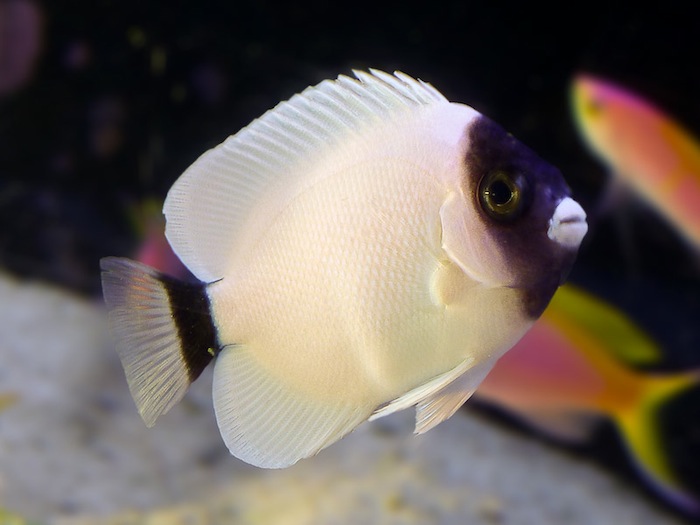
The recently collected masked angelfish which was bought and sold by House of Fins, Greenwich CT. Photo by Lluis Turon.
The masked angelfish, Genicanthus personatus, is an idolized reef fish which is as beautiful as it is expensive and rarely seen. The stunning marble-white body coloration of the masked angelfish is accentuated by a perimeter of color that gives the masked angelfish a truly angelic appearance. Masked angelfish are endemic to Hawai’i and they are most abundant in the Northwestern Hawaiian Islands where most commercial activity including the collection of aquarium fish is strictly prohibited. Where collection of aquarium fish is allowed, the masked angelfish only occurs in extremely deep water at the edge of diving limits. Although the masked angelfish has been bred, it happened only once in captivity and Genicanthus personatus is still one of the most high profile marine aquarium fish in the world.
No other group of reef fish has captivated the aquarium hobby like the colorful and varied angelfish. Among the family Pomacanthidae which includes over 90 species, a few species are iconic in the aquarium hobby and a few them are ambassadors of the marine environment to the general public. Motifs of emperor, flame, peppermint and queen angelfish can be seen reproduced in much of the general literature on coral reefs and the marine environment. Of all the angelfish species, the swallowtail angelfish of the Genicanthus genus receive the least attention in reef and fish aquariums, but since they eat mostly zooplankton and some varied benthic foods, they are very well suited to life in an aquarium. Even in a group of fish that is crowded with extremely bold colors and patterns, the masked angelfish is still highly regarded by all who are informed about the details of this species.
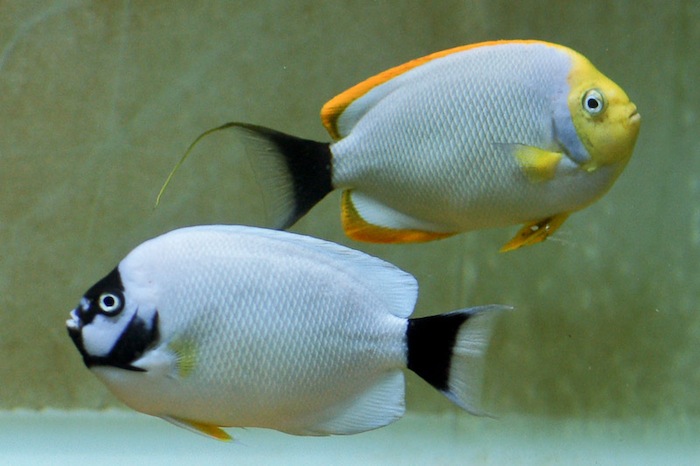
This large mature pair of masked angelfish clearly show the differences in appearance between the make and female. Photo by Chung Wing Hung.
The masked angelfish was first discovered in 1972 from a single specimen captured near Waikiki, a female specimen that formed the basis of the first description of Genicanthus personatus in 1975 by John Randall. Later that year the first male specimen was discovered and the species was redescribed to include the coloration of both sexes. G. personatus grows to a maximum length of eight inches (~20cm) but the caudal fin filaments of a mature male can be several inches long as well.
Unlike most high profile rare, exotic and expensive reef fish, the fully grown masked angelfish does not have any wild or crazy coloration and it barely sports any markings at all. The masked angelfish is a predominantly white fish, and if that was all there is to it, the masked angelfish would still be a unique fish in the sea as there are not many species with a stark white color. The white coloration of the masked angelfish is a not at all a pale white, but a brilliant white which gives it a stunning appearance at all stages of its life cycle. As a juvenile the tiny white masked angelfish only has a small black patch over its face, eyes and mouth included. Adolescent masked angelfish eventually develop a mostly black tail and the black facial mask becomes punctuated with blueish white lips.
Masked angelfish are protogynous hermaphrodites (they start out life as a female and eventually turn into males) and they are sexually dichromatic (a separate coloration for males and females). A fully grown female masked angelfish has an all white body color, retaining the mostly black tail, yellow pelvic fins and the black mask becomes reduced in size. The amount of black on the female masked angelfish shrinks to a small black patch which may encircle the eyes, with a little black under the lips and a black edging to the gill cover and gill spine.
At about six to seven inches long a female masked angelfish will switch to a male sex and male coloration. The male masked angelfish also retains the black tail fin but its pectoral fins, its entire face and the edge of its dorsal, **** and pelvic fins become a bright yellow-orange color. As an added bonus, like other members of the Genicanthus genus the male masked angelfish also develops long streamers to its caudal fin. On rare occasions the male masked angelfish will temporarily display an overall grey body coloration which is used to signal cleaner fish and shrimp that it is safe to approach for removing parasites and little bits of dead tissue. Needless to say a stark white fish framed by bold yellow coloration is not likely to be confused with any other fish.
The masked angelfish is endemic to Hawaii and it occurs all along the 1500 mile length of the Pacific Ocean island chain, but it exhibits a graduated depth distribution throughout the Hawaiian Islands. The masked angelfish can be reliably sighted at over 300 feet deep in Kauai and it occurs progressively shallower as you go west to the Northwestern Hawaiian Islands. At the extreme end of this range is Pearle and Hermes reef where the masked angelfish can be frequently spotted in less than 100 feet of water. The fact that masked angelfish occurs deeper at more southerly locations is an indication of its preference for cooler water.
Over the last decade, only one or two specimens of masked angelfish have been collected alive every year, and some years there were none to be had for a would-be aquarium collector. The extremely slow trickle of aquarium masked angelfish coupled with a very high global demand means that this fish usually retails for ten to fifteen thousand dollars. The high cost of the masked angelfish garners attention not only from the aquarium world but also from Hawaiian fish collectors who go to great length to collect the valuable masked angelfish. About half of the masked angelfish that are captured are usually collected by divers targeting that species, or it is out of sheer luck with the occasional waif specimen occurring well outside its normal depth for the geographic area where it is found.
There have been several well documented cases of live collection of masked angelfish over the last few years. In early 2009 a pair of masked angelfish made their way to B-Box Aquarium in Japan and they were sold to a rare fish collector in Hong Kong for $30,000. Late last summer 2010 Rob Lower succeeded in capturing some specimens of masked angelfish in Kauai, but less than a month later Mr. Lower suffered dive related injuries that cost him his life. Around that same time Rufus Kimura captured a tiny masked angelfish in only 250 feet of water near Oahu. Blue Harbor in Japan was fist to share pictures of this one inch long G. personatus and this juvenile has been growing and well-documented in videos like the one below. More recently, Hawaiian fish collector Matt Ross struck white gold while he was looking for Potter’s angelfish. Mr. Ross collected a medium sized masked angelfish in only 100 feet of water but unlike the first two Japan-bound specimens, this last specimen was handled by House of Fins in Greenwich CT. Since this medium sized masked angelfish is approximately the same size as the aquarium grown specimen captured previously by Rufus Kimura, it is possible that both of these latest waifs found outside of their typical depth and range may have belonged to the same cohort of juvenile masked angelfish.
So what does it take to be one of the most sought after marine aquarium fish of all time? Angelfish? check. Unique and bold body coloration? check. Limited distribution? Check. High price and limited availability? check. Some fish make a big splash right when they are discovered but what really matters is the lasting appeal of the species. Since the masked angelfish was first described and pictured in 1975, the popularity and interest in this fish has done nothing but grown. Because of its price, color and limited availability, the masked angelfish is truly a perfect storm for a highly desirable reef aquarium fish.


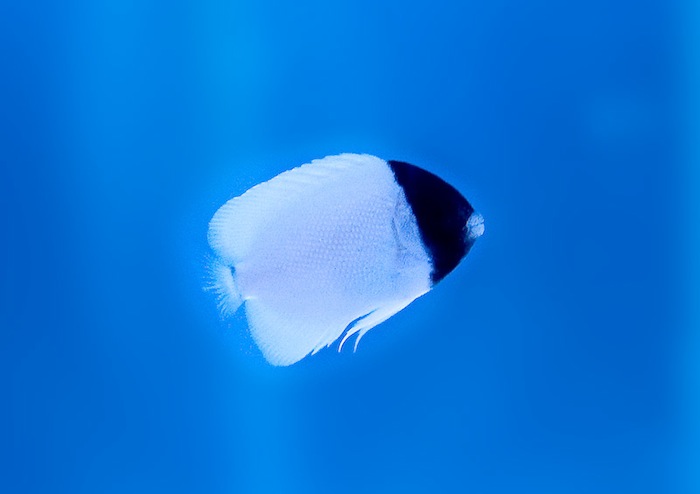
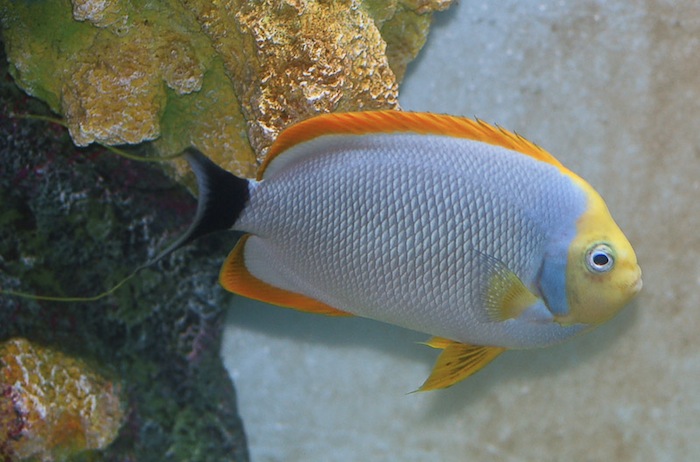
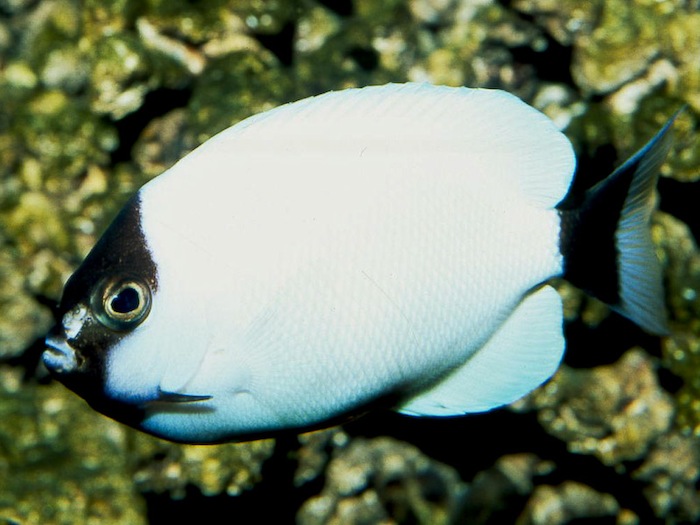

0 Comments